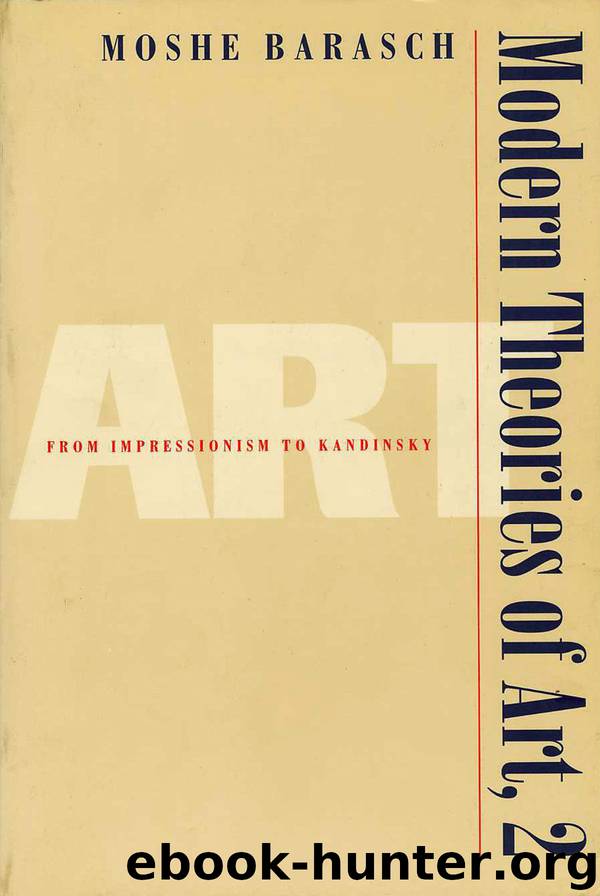Modern Theories of Art 2 by Barasch Moshe;

Author:Barasch, Moshe;
Language: eng
Format: epub
Publisher: New York University Press
Published: 1998-04-14T16:00:00+00:00
NOTES
1. See Arthur O. Lovejoy and George Boas, Primitivism and Related Ideas in Antiquity (Baltimore, 1935), especially pp. 1 ff.
2. Lovejoy and Boas, Primitivism, p.8.
3. For a good introduction to the study of the Wunderkammern, see the still valuable work by Julius von Schlosser, Die Kunst- und Wunderkammern der Spät-Renaissance (Leipzig, 1908).
4. See P. F. de Siebold, Lettre sur l’utilité des Musées Ethnographiques et sur l’importance de leur création dans les états qui possèdent des Colonies (Paris, 1843). And cf. the observations by Robert Goldwater, Primitivism in Modern Art (Cambridge, Mass., 1986; original edition: 1938), pp. 4 ff.
5. Goldwater, Primitivism, pp. 315–19 gives a very useful “Summary Chronology of Ethnographical Museums and Exhibitions.” The main difficulty with this list is that it does not separate the tribal from the exotic, say, the African and Oceanian from the Japanese and Chinese. However, this should not be construed as a criticism; the difficulty was inherent in the cultural situation of Europe.
6. The literature is, of course, large. But see M. I. Gothein, A History of Garden Art (London and Toronto, n.d.); the German original appeared in Jena, 1926. For the general context, see the still interesting article by Lovejoy, “The Chinese Origin of a Romanticism,” reprinted in Arthur O. Lovejoy, Essays in the History of Ideas (New York, 1960), pp. 99–135.
7. The quotations are from a review Apollinaire wrote in 1911. See Leroy C. Breuning, ed., Apollinaire on Art: Essays and Reviews, 1902–1918, translated by Susan Suleiman (New York, 1972), pp. 164 ff.
8. See D. S. Maccoll, “The Logic of Painting,” published in 1892; here quoted from Flint, The Impressionists in England, (London, 1984), p. 118.
9. From an article by Winford Dewhurst, published in 1904, and here quoted from Flint, The Impressionists in England, p. 192.
10. Flint, The Impressionists in England, p. 192.
11. Taken from an article on Degas by Duret. The article is reprinted in Flint, The Impressionists in England, pp. 296 ff.; the sentence quoted may be found on p. 297.
12. This characterization of Chinese paintings is found in an article published in 1911. See Breuning, Apollinaire on Art, pp. 127 ff., especially p. 128.
13. Flint, The Impressionists in England, pp. 143 ff., especially p. 145.
14. Flint, The Impressionists in England, p. 118.
15. Flint, The Impressionists in England, p. 267.
16. In an article published in 1903, and reprinted in Flint, The Impressionists in England, p. 343 ff. For the sentence quoted, see p. 347.
17. See below, chapter 25.
Download
This site does not store any files on its server. We only index and link to content provided by other sites. Please contact the content providers to delete copyright contents if any and email us, we'll remove relevant links or contents immediately.
Cecilia; Or, Memoirs of an Heiress — Volume 1 by Fanny Burney(32273)
Cecilia; Or, Memoirs of an Heiress — Volume 3 by Fanny Burney(31653)
Cecilia; Or, Memoirs of an Heiress — Volume 2 by Fanny Burney(31626)
The Great Music City by Andrea Baker(31034)
We're Going to Need More Wine by Gabrielle Union(18835)
All the Missing Girls by Megan Miranda(15192)
Pimp by Iceberg Slim(14088)
Bombshells: Glamour Girls of a Lifetime by Sullivan Steve(13864)
Talking to Strangers by Malcolm Gladwell(13077)
Fifty Shades Freed by E L James(13069)
Norse Mythology by Gaiman Neil(13048)
For the Love of Europe by Rick Steves(12002)
Crazy Rich Asians by Kevin Kwan(9065)
Mindhunter: Inside the FBI's Elite Serial Crime Unit by John E. Douglas & Mark Olshaker(8995)
The Lost Art of Listening by Michael P. Nichols(7317)
Enlightenment Now: The Case for Reason, Science, Humanism, and Progress by Steven Pinker(7040)
The Four Agreements by Don Miguel Ruiz(6492)
Bad Blood by John Carreyrou(6421)
Weapons of Math Destruction by Cathy O'Neil(6026)
